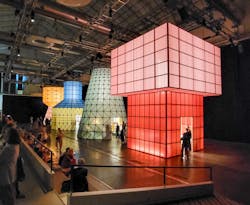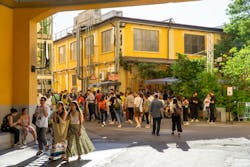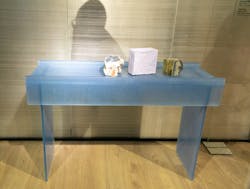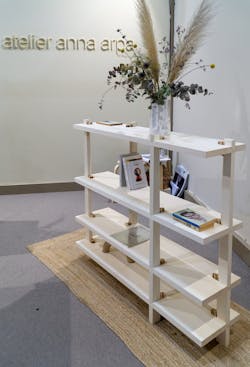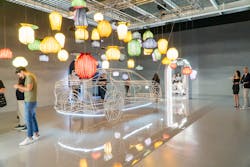Milan Design Week is a seemingly never-ending, weeklong mind party, for designers, design enthusiasts and anyone that loves creators and their creations. The sensory overload of energy and inspiration is nothing short of addictive, whether you’re at the Salone Del Mobile fair, held just outside of the city, or wandering Fuorisalone, the official name for the several Design Districts that pop up throughout Milan … more casually known simply as Design Week.
The last full-caliber Design Week happened in 2019. To celebrate the return of the pre-pandemic crowds this year exhibitors and venues gleefully exploited Milan’s greatest recent export: Aperitivo happy hours, with variations on the Prosecco-fueled Aperol spritz and endless plates of savory nibbles. Companies like Alessi hired rock-star-famous mixologists to make sure their Aperitivo events set a very high bar. The idea was so popular it caused a serious shortage of ice in the city.
Two years of cabin fever had an unmistakable impact on design. The calming comfort of nature-inspired colors ruled, mostly in softer hues, with one exception: blues were everywhere, from gentle baby blues to intense cobalt. The exception to this rule was hot pink, but that was found almost exclusively in women’s fashion … no doubt also a reaction to the many miserable months of lockdown.
That softness was also expressed in upholstered furniture where, in the spirit of “form follows function,” comfort is all the rage.
While the traditional areas of the fair are impressive and even awe-inspiring, I tend to gravitate to the section known as SaloneSatellite, a special area dedicated to young designers. To be invited show at Satellite you have to be under 35 years old, and you get a standard 10’ x 10’ space. Dozens and dozens of young designers, architects, artisans and students are there with their concepts–very few have products on the market–hoping to be selected for a SaloneSatellite Award, or even better, to be discovered by a major furniture company. This is where you get to have real conversations with passionate, young idealists, the actual creators, versus the main fair exhibits where you’ll most likely get stuck with a furniture company salesperson.
‘The Hugging Chair’
“The hugging chair is designed for autistic people,” Audrain said. “The inflatable walls put as much pressure on your body as you want, and it helps them reduce tension and anxiety, and to be more receptive to social interaction or learning.
“This prototype is used in hospital in France with 26 children with autism, as part of a research project. I have a friend who works with autistic people, and we worked together with them throughout the design process,” she added.
(Find out more about the hugging chair, and Alexia, at www.oto-chair.com.)
‘No Glues, No Screws’
“These are all waste pieces of wood,” she said, leaning on table made of a colorful, intricate mosaic of small wood chips precisely set at 30-degree angles.
“I get the waste pieces from the artisans and make them this size. There are 10 different wood species, and these are their natural colors. This tabletop is made up around 15,000 pieces of wood,” she explained
It’s based on the study of wooden joinery, Arpa says, no hardware, no adhesives. “These pieces are enjoined.”
Apra isn’t a woodworker. She’s a Milan-born architect that studied in Switzerland and France, and has worked in Berlin and New York.
“And now I'm in Italy trying to realize my dream of decreasing the scales and giving more details.”
(To view more about her work, connect with her on Instagram at [email protected], @atelier_anna_arpa)
Hermès and Lexus: Looking for Light, Sparks of Tomorrow
Designedby Hervé Sauvage and Charlotte Macaux Perelman, the towers glow from within, beckoning visitors to experience celebrations of color and form realized in hand-crafted leather, cashmere and porcelain.
Lexus was also all about lightness with their immersive “Sparks of Tomorrow” installation created by award-winning architect and designer Germane Barnes, with colorful lighting studio Aqua Creations. The centerpiece was a full-size, floating 3D wireframe sculpture of the company’s RZ carbon-neutral electric car, surrounded by prototypes from Lexus Design Award winners and, naturally, a swing.
‘Colorflage’
And that is a perfect introduction to Markus Benesch. Born in Munich but well established in New York and Milan, Benesch pioneered digitally printed laminates with Abet Laminati and has worked extensively bringing out-of-the-box design ideas to major wallcovering brands like Rasch. With Markus Benesch Creates and his Curious Boy brand he brings to life his playful, colorful ideas in surfaces, interiors, furniture and art.
This year in the 5VIE (pronounced “cinque vee”) District he delighted with several furniture pieces made of composite wood with colorful acrylic inserts, each with a story. But the tall, striking double doors were his show stealer.
“These are an exact reproduction of the doors at the end of a dark hallway in our apartment in New York," he said. "My wife pointed out that the room on the other side of the doors had so much light, maybe we should have a glass door. Instead, we 3-D scanned our wood doors, CNC machined them out of pine, and added all of these colorful little windows.”
Benesch moulded dozens of richly colored translucent inserts into the doors, using shapes he refers to as “an alien alphabet,” carried over from concepts he first brought to Design Week in 2019. Working acrylic perfectly and permanently into wood required years of trial and error, and Benesch has pieces that are several years old and show no signs of material separation.
“This is all part of our ‘Colorflage’ concept," he explained. "We want people to stop hiding, stop camouflaging, to be expressive, to let what’s inside out. That’s why the theme of our showroom party is “Show Us Your Colors!”
Benesch’s party, by the way, started later than planned. The ice almost didn’t make it.
(Learn more at markusbeneschcreates.com.)
About the Author

Kenn Busch
Contributing Editor
Kenn Busch is a longtime journalist, educator and public speaker dedicated to bridging the knowledge gap between materials, sustainability, and furniture and interior architecture. He is the founder of MateralIntelligence.com and ClimatePositiveNOW.org, two major resources for design and manufacturer specifiers.
